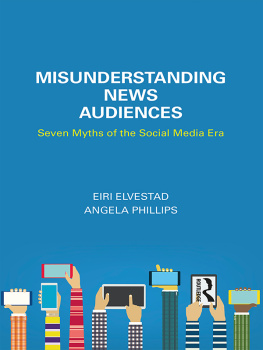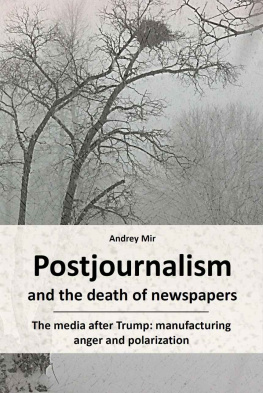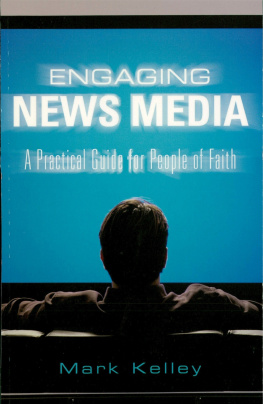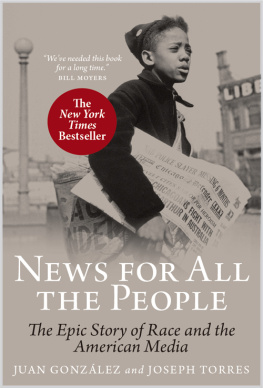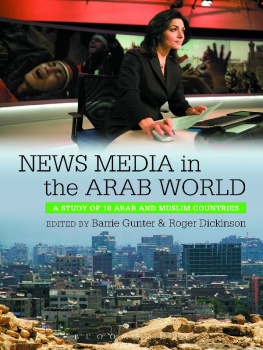Content is King
Content is King
News media management in the digital age
GARY GRAHAM, ANITA GREENHILL, DONALD SHAW, AND CHRIS J. VARGO
Bloomsbury Academic
An imprint of Bloomsbury Publishing Inc
Contents
Gordon Fletcher is a senior lecturer in Information Systems at the Salford Business School, University of Salford, UK. He is the codirector of the Centre for Digital Business and the author of many articles and book sections on the intersections of the digital and cultural.
Gary Graham is an associate professor in Operations Management at the Leeds University Business School, UK. He is the author of thirty internationally refereed research papers, a coinvestigator on six EPSRC/ESRC grants, and the author of three books.
Anita Greenhill is a senior lecturer in People, Management and Organisations at the Manchester Business School, the University of Manchester, UK. Greenhill has published over sixty articles in fields such as information technologies, sociology, virtual communities, policy and education, and qualitative research methods.
Maria Jos Hernndez Serrano is a professor in the Department of Education Theory and History at the University of Salamanca, Spain. She has participated in various international conferences, presenting work on learning with information technology, and has authored numerous articles on education in the digital age.
John Hill was formerly a visiting research fellow at Leeds University Business School, UK, and Manchester Business School, UK, where he applied his forty years in the newspaper industry in the UK, Africa, and the Middle East to academic examinations of the field of communications.
Paul Jones is a clinical professor in the School of Information and Library Science at the University of North Carolina at Chapel Hill, USA. He is the director of ibiblio.org, a digital library of public domain and creative commons media.
Young Mie Kim is an associate professor in the School of Journalism and Mass Communication and Donovan Wright Faculty Fellow of the College of Letters and Science at the University of Wisconsin-Madison, USA. Kims research has appeared in journals such as Communication Research , the Journal of Communication , the Journal of Politics , and others.
Donald L. Shaw is Kenan Professor in the School of Journalism and Mass Communication at the University of North Carolina at Chapel Hill, USA. He is best known for his work on the agenda-setting function of the press with Max McCombs and for his studies of nineteenth- and twentieth-century American and Southern press history.
Mikko Sihvonen is an associate lecturer in the Department of Languages, Information and Communications at Manchester Metropolitan University, UK. His past research has focused on how political and economic trends influence cultural institutions in broadcasting.
Seamus Simpson is a professor of media policy in the School of Arts and Media at the University of Salford, UK. His research focuses on a range of Internet, telecommunication and digital media convergence governance issues. He is senior editor of the Oxford Research Encyclopedia: Communication .
Chris J. Vargo is an assistant professor of public relations at the University of Alabama, USA. His research uses computer science methods to investigate social media using theories from the communication and political science disciplines.
Donald L. Shaw, Chris J. Vargo, Gary Graham, and Anita Greenhill
UNDERSTANDING why some companies succeed and others fail is an interesting challenge. Many techniques, including the use of Charles Darwins theory of evolution, have been used to explain how organizations evolve. This book explores the deep social and commercial structure of the strategic response of newspapers to the current turbulence being created by the digital age. Newspapers face many strategic challenges if they are to identify and build appropriate digital business models and strategies in order to sustain themselves. Digital-age turbulence opens up market conditions and opportunities for the news industry when adjusting to these Internet, Web 2.0, and civic media technologies.
Turbulence delivers opportunities as well as chaos, risk, and uncertainty. It is important for the news industry to consider how it strategically aligns its production structure, markets, and competitors to this environment. Digital turbulence is leading to two major effects that managers need to consider: One is that the news firm needs to be able to defend itself from rapid market erosion; and the other is opportunity, which it needs to exploit. While many of the news companies around the world were ill prepared to succeed in an environment of continuous, unpredictable turbulence, they are now more aware of the need to absorb and deal with volatile change.
The mission for newspapers in this hybrid physical/digital marketplace seems a simple one: To create content that will satisfy the full range of consumers news needs and then build the links that will connect people to the relevant news they seek. However, this is much easier to say than it is to accomplish in a news environment characterized by fragmented interests and mostly passive consumption patterns across online and off-line news venues. There is a convincing case that the old models for packaging and delivering news no longer connect effectively with the audience now coming of age around the world. The habits of young consumers are radically different from those that have characterized news consumption for generations. Newspapers, scheduled broadcasts, and even websites have given way to a chaotic system of self-aggregation; this is producing disappointing results not only for news producers butas this book showsfor consumers as well.
Our approach is not designed to focus purely on the strategic achievements of the news media, such as the development of a successful publication, or to report how they have successfully exploited a new market opportunity. Instead, it pushes and reinforces the idea that, for the local news media to survive, it needs to sustain itself as the primary information artery flowing into communities (Laswell, 1948). With the planned development of information-rich and data-driven cities (e.g., the era of big data and smart and intelligent cities), the crucial need for (and value of) authentic and reliable news sources have never been greater. Due to the proliferation of smart devices and interconnected services, cities are gushing with data, much of which relates to human behavior.
City life generates data streams around online social media, telecommunication, geolocation, crime, health, transport, air quality, energy, utilities, weather, CCTV, Wi-Fi usage, retail footfall, and satellite imaging. In modeling terms, the historical surgical extraction of the newspaper from its city surroundings may not be appropriate, and an open news model, subject to a range of external influences, may be more realistic. The news firm could make the volumes of data scalable for the community.
Local newspapers have a vital role to play in connecting communities together in these rapidly emerging future city landscapes. Although work on the future of the news industry tends to take a technological or economic standpoint, here we try and include a human and community dimension that focuses on the social factors involved in shaping strategy, something that is often overlooked. We critically portray the future media roles of community and consumers to be integrated and participative in the local news space.


